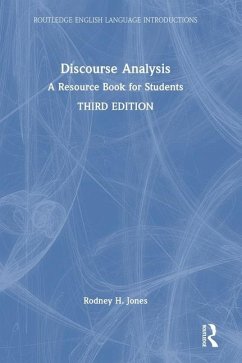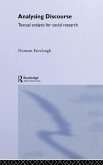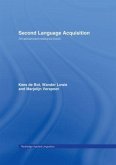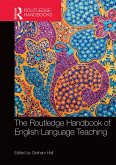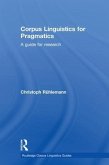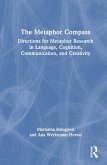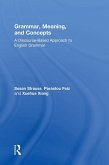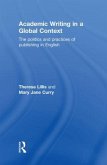- Gebundenes Buch
- Merkliste
- Auf die Merkliste
- Bewerten Bewerten
- Teilen
- Produkt teilen
- Produkterinnerung
- Produkterinnerung
Revised and updated throughout, the new edition of Discourse Analysis provides a comprehensive overview of the major approaches to and methodological tools used in discourse analysis.
Andere Kunden interessierten sich auch für
![Analysing Discourse Analysing Discourse]() Norman FaircloughAnalysing Discourse188,99 €
Norman FaircloughAnalysing Discourse188,99 €![Second Language Acquisition Second Language Acquisition]() Kees de BotSecond Language Acquisition198,99 €
Kees de BotSecond Language Acquisition198,99 €![The Routledge Handbook of English Language Teaching The Routledge Handbook of English Language Teaching]() The Routledge Handbook of English Language Teaching349,99 €
The Routledge Handbook of English Language Teaching349,99 €![Corpus Linguistics for Pragmatics Corpus Linguistics for Pragmatics]() Christoph RühlemannCorpus Linguistics for Pragmatics200,99 €
Christoph RühlemannCorpus Linguistics for Pragmatics200,99 €![The Metaphor Compass The Metaphor Compass]() Marianna BolognesiThe Metaphor Compass165,99 €
Marianna BolognesiThe Metaphor Compass165,99 €![Grammar, Meaning, and Concepts Grammar, Meaning, and Concepts]() Susan StraussGrammar, Meaning, and Concepts185,99 €
Susan StraussGrammar, Meaning, and Concepts185,99 €![Academic Writing in a Global Context Academic Writing in a Global Context]() Theresa LillisAcademic Writing in a Global Context187,99 €
Theresa LillisAcademic Writing in a Global Context187,99 €-
-
-
Revised and updated throughout, the new edition of Discourse Analysis provides a comprehensive overview of the major approaches to and methodological tools used in discourse analysis.
Hinweis: Dieser Artikel kann nur an eine deutsche Lieferadresse ausgeliefert werden.
Hinweis: Dieser Artikel kann nur an eine deutsche Lieferadresse ausgeliefert werden.
Produktdetails
- Produktdetails
- Verlag: Routledge
- 3. Auflage
- Seitenzahl: 274
- Erscheinungstermin: 21. Mai 2024
- Englisch
- Abmessung: 260mm x 183mm x 19mm
- Gewicht: 716g
- ISBN-13: 9781032455297
- ISBN-10: 1032455292
- Artikelnr.: 70151960
- Herstellerkennzeichnung
- Libri GmbH
- Europaallee 1
- 36244 Bad Hersfeld
- gpsr@libri.de
- Verlag: Routledge
- 3. Auflage
- Seitenzahl: 274
- Erscheinungstermin: 21. Mai 2024
- Englisch
- Abmessung: 260mm x 183mm x 19mm
- Gewicht: 716g
- ISBN-13: 9781032455297
- ISBN-10: 1032455292
- Artikelnr.: 70151960
- Herstellerkennzeichnung
- Libri GmbH
- Europaallee 1
- 36244 Bad Hersfeld
- gpsr@libri.de
Rodney H. Jones is Professor of Sociolinguistics at the University of Reading, UK. His other titles with Routledge include Language and Media: A Resource Book for Students, Second Edition (with Sylvia Jaworska and Erhan Aslan, Routledge 2020) and Understanding Digital Literacies: A Practical Introduction, Second Edition (with Christoph A. Hafner, Routledge 2021). He is also editor of The Routledge Handbook of Language and Creativity (Routledge 2015).
Contents cross-referenced
List of figures and tables
Acknowledgements
A Introduction: Key topics in the study of discourse analysis
1 What is discourse analysis?
2 Texts and texture
3 Texts and their social functions
4 Discourse and ideology
5 Spoken discourse
6 Strategic interaction
7 Context, culture and communication
8 Mediated discourse analysis
9 Multimodal discourse analysis
10 Corpus-assisted discourse analysis
B Development: Approaches to discourse analysis
1 Three ways of looking at discourse
2 Cohesion, coherence and intertextuality
3 All the right moves
4 Constructing reality
5 The texture of talk
6 Negotiating relationships and activities
7 The SPEAKING model
8 Mediation
9 Modes, meaning and action
10 Procedures for corpus-assisted discourse analysis
C Exploration: Analysing discourse
1 Doing discourse analysis: first steps
2 Analysing texture
3 Analysing genres
4 Competing Discourses
5 Analysing speech acts
6 Conversational strategies online
7 Analysing contexts
8 Doing mediated discourse analysis
9 Analysing multimodality
10 Analysing corpora
D Extension: Research in discourse analysis
1 The little texts in our lives
2 Texture: Old and new
3 Online genres and discourse communities
4 Ideologies in discourse
5 Conversations in online 'dating' and 'grooming'
6 'Coaching' and 'bragging': Positioning and politeness in discourse
7 Ethnographic approaches to discourse analysis
8 Discourse and action
9 Identity, stereotypes, and multimodal discourse analysis
10 Corpus-assisted discourse analysis
Further reading
References
Author index
Glossarial index
List of figures and tables
Acknowledgements
A Introduction: Key topics in the study of discourse analysis
1 What is discourse analysis?
2 Texts and texture
3 Texts and their social functions
4 Discourse and ideology
5 Spoken discourse
6 Strategic interaction
7 Context, culture and communication
8 Mediated discourse analysis
9 Multimodal discourse analysis
10 Corpus-assisted discourse analysis
B Development: Approaches to discourse analysis
1 Three ways of looking at discourse
2 Cohesion, coherence and intertextuality
3 All the right moves
4 Constructing reality
5 The texture of talk
6 Negotiating relationships and activities
7 The SPEAKING model
8 Mediation
9 Modes, meaning and action
10 Procedures for corpus-assisted discourse analysis
C Exploration: Analysing discourse
1 Doing discourse analysis: first steps
2 Analysing texture
3 Analysing genres
4 Competing Discourses
5 Analysing speech acts
6 Conversational strategies online
7 Analysing contexts
8 Doing mediated discourse analysis
9 Analysing multimodality
10 Analysing corpora
D Extension: Research in discourse analysis
1 The little texts in our lives
2 Texture: Old and new
3 Online genres and discourse communities
4 Ideologies in discourse
5 Conversations in online 'dating' and 'grooming'
6 'Coaching' and 'bragging': Positioning and politeness in discourse
7 Ethnographic approaches to discourse analysis
8 Discourse and action
9 Identity, stereotypes, and multimodal discourse analysis
10 Corpus-assisted discourse analysis
Further reading
References
Author index
Glossarial index
Contents cross-referenced
List of figures and tables
Acknowledgements
A Introduction: Key topics in the study of discourse analysis
1 What is discourse analysis?
2 Texts and texture
3 Texts and their social functions
4 Discourse and ideology
5 Spoken discourse
6 Strategic interaction
7 Context, culture and communication
8 Mediated discourse analysis
9 Multimodal discourse analysis
10 Corpus-assisted discourse analysis
B Development: Approaches to discourse analysis
1 Three ways of looking at discourse
2 Cohesion and coherence
3 All the right moves
4 Constructing reality
5 The texture of talk
6 Negotiating relationships and activities
7 The SPEAKING model
8 Mediation
9 Modes, meaning and action
10 Procedures for corpus-assisted discourse analysis
C Exploration: Analysing discourse
1 Doing discourse analysis: first steps
2 Analysing texture
3 Analysing genres
4 Other people's voices
5 Analysing speech acts
6 Analysing conversational strategies
7 Analysing contexts
8 Doing mediated discourse analysis
9 Analysing multimodality
10 Analysing corpora
D Extension: Readings in discourse analysis
1 The three perspectives revisited (Zellig Harris; Henry G. Widdowson; James Paul Gee)
2 Two perspectives on texture (Michael A.K. Halliday and Ruqaiya Hasan; David Rumelhart)
3 Genres, discourse communities and power (John Swales; Vijay K. Bhatia)
4 Ideologies in discourse (Norman Fairclough; James Paul Gee)
5 Two perspectives on conversation (John L. Austin; Emanuel A. Schegloff and Harvey Sacks)
6 Frames in interaction (Deborah Tannen and Cynthia Wallat)
7 The ethnography of communication (Dell Hymes; Muriel Saville-Troike)
8 Discourse and action (Ron Scollon)
9 Two perspectives on multimodality (Gunther Kress and Theo van Leeuwen; Sigrid Norris)
10 Finding 'Discourses' with corpus-assisted analysis (Paul Baker and Tony McEnery)
Further reading
References
Author index
Glossarial index
List of figures and tables
Acknowledgements
A Introduction: Key topics in the study of discourse analysis
1 What is discourse analysis?
2 Texts and texture
3 Texts and their social functions
4 Discourse and ideology
5 Spoken discourse
6 Strategic interaction
7 Context, culture and communication
8 Mediated discourse analysis
9 Multimodal discourse analysis
10 Corpus-assisted discourse analysis
B Development: Approaches to discourse analysis
1 Three ways of looking at discourse
2 Cohesion and coherence
3 All the right moves
4 Constructing reality
5 The texture of talk
6 Negotiating relationships and activities
7 The SPEAKING model
8 Mediation
9 Modes, meaning and action
10 Procedures for corpus-assisted discourse analysis
C Exploration: Analysing discourse
1 Doing discourse analysis: first steps
2 Analysing texture
3 Analysing genres
4 Other people's voices
5 Analysing speech acts
6 Analysing conversational strategies
7 Analysing contexts
8 Doing mediated discourse analysis
9 Analysing multimodality
10 Analysing corpora
D Extension: Readings in discourse analysis
1 The three perspectives revisited (Zellig Harris; Henry G. Widdowson; James Paul Gee)
2 Two perspectives on texture (Michael A.K. Halliday and Ruqaiya Hasan; David Rumelhart)
3 Genres, discourse communities and power (John Swales; Vijay K. Bhatia)
4 Ideologies in discourse (Norman Fairclough; James Paul Gee)
5 Two perspectives on conversation (John L. Austin; Emanuel A. Schegloff and Harvey Sacks)
6 Frames in interaction (Deborah Tannen and Cynthia Wallat)
7 The ethnography of communication (Dell Hymes; Muriel Saville-Troike)
8 Discourse and action (Ron Scollon)
9 Two perspectives on multimodality (Gunther Kress and Theo van Leeuwen; Sigrid Norris)
10 Finding 'Discourses' with corpus-assisted analysis (Paul Baker and Tony McEnery)
Further reading
References
Author index
Glossarial index
Contents cross-referenced
List of figures and tables
Acknowledgements
A Introduction: Key topics in the study of discourse analysis
1 What is discourse analysis?
2 Texts and texture
3 Texts and their social functions
4 Discourse and ideology
5 Spoken discourse
6 Strategic interaction
7 Context, culture and communication
8 Mediated discourse analysis
9 Multimodal discourse analysis
10 Corpus-assisted discourse analysis
B Development: Approaches to discourse analysis
1 Three ways of looking at discourse
2 Cohesion, coherence and intertextuality
3 All the right moves
4 Constructing reality
5 The texture of talk
6 Negotiating relationships and activities
7 The SPEAKING model
8 Mediation
9 Modes, meaning and action
10 Procedures for corpus-assisted discourse analysis
C Exploration: Analysing discourse
1 Doing discourse analysis: first steps
2 Analysing texture
3 Analysing genres
4 Competing Discourses
5 Analysing speech acts
6 Conversational strategies online
7 Analysing contexts
8 Doing mediated discourse analysis
9 Analysing multimodality
10 Analysing corpora
D Extension: Research in discourse analysis
1 The little texts in our lives
2 Texture: Old and new
3 Online genres and discourse communities
4 Ideologies in discourse
5 Conversations in online 'dating' and 'grooming'
6 'Coaching' and 'bragging': Positioning and politeness in discourse
7 Ethnographic approaches to discourse analysis
8 Discourse and action
9 Identity, stereotypes, and multimodal discourse analysis
10 Corpus-assisted discourse analysis
Further reading
References
Author index
Glossarial index
List of figures and tables
Acknowledgements
A Introduction: Key topics in the study of discourse analysis
1 What is discourse analysis?
2 Texts and texture
3 Texts and their social functions
4 Discourse and ideology
5 Spoken discourse
6 Strategic interaction
7 Context, culture and communication
8 Mediated discourse analysis
9 Multimodal discourse analysis
10 Corpus-assisted discourse analysis
B Development: Approaches to discourse analysis
1 Three ways of looking at discourse
2 Cohesion, coherence and intertextuality
3 All the right moves
4 Constructing reality
5 The texture of talk
6 Negotiating relationships and activities
7 The SPEAKING model
8 Mediation
9 Modes, meaning and action
10 Procedures for corpus-assisted discourse analysis
C Exploration: Analysing discourse
1 Doing discourse analysis: first steps
2 Analysing texture
3 Analysing genres
4 Competing Discourses
5 Analysing speech acts
6 Conversational strategies online
7 Analysing contexts
8 Doing mediated discourse analysis
9 Analysing multimodality
10 Analysing corpora
D Extension: Research in discourse analysis
1 The little texts in our lives
2 Texture: Old and new
3 Online genres and discourse communities
4 Ideologies in discourse
5 Conversations in online 'dating' and 'grooming'
6 'Coaching' and 'bragging': Positioning and politeness in discourse
7 Ethnographic approaches to discourse analysis
8 Discourse and action
9 Identity, stereotypes, and multimodal discourse analysis
10 Corpus-assisted discourse analysis
Further reading
References
Author index
Glossarial index
Contents cross-referenced
List of figures and tables
Acknowledgements
A Introduction: Key topics in the study of discourse analysis
1 What is discourse analysis?
2 Texts and texture
3 Texts and their social functions
4 Discourse and ideology
5 Spoken discourse
6 Strategic interaction
7 Context, culture and communication
8 Mediated discourse analysis
9 Multimodal discourse analysis
10 Corpus-assisted discourse analysis
B Development: Approaches to discourse analysis
1 Three ways of looking at discourse
2 Cohesion and coherence
3 All the right moves
4 Constructing reality
5 The texture of talk
6 Negotiating relationships and activities
7 The SPEAKING model
8 Mediation
9 Modes, meaning and action
10 Procedures for corpus-assisted discourse analysis
C Exploration: Analysing discourse
1 Doing discourse analysis: first steps
2 Analysing texture
3 Analysing genres
4 Other people's voices
5 Analysing speech acts
6 Analysing conversational strategies
7 Analysing contexts
8 Doing mediated discourse analysis
9 Analysing multimodality
10 Analysing corpora
D Extension: Readings in discourse analysis
1 The three perspectives revisited (Zellig Harris; Henry G. Widdowson; James Paul Gee)
2 Two perspectives on texture (Michael A.K. Halliday and Ruqaiya Hasan; David Rumelhart)
3 Genres, discourse communities and power (John Swales; Vijay K. Bhatia)
4 Ideologies in discourse (Norman Fairclough; James Paul Gee)
5 Two perspectives on conversation (John L. Austin; Emanuel A. Schegloff and Harvey Sacks)
6 Frames in interaction (Deborah Tannen and Cynthia Wallat)
7 The ethnography of communication (Dell Hymes; Muriel Saville-Troike)
8 Discourse and action (Ron Scollon)
9 Two perspectives on multimodality (Gunther Kress and Theo van Leeuwen; Sigrid Norris)
10 Finding 'Discourses' with corpus-assisted analysis (Paul Baker and Tony McEnery)
Further reading
References
Author index
Glossarial index
List of figures and tables
Acknowledgements
A Introduction: Key topics in the study of discourse analysis
1 What is discourse analysis?
2 Texts and texture
3 Texts and their social functions
4 Discourse and ideology
5 Spoken discourse
6 Strategic interaction
7 Context, culture and communication
8 Mediated discourse analysis
9 Multimodal discourse analysis
10 Corpus-assisted discourse analysis
B Development: Approaches to discourse analysis
1 Three ways of looking at discourse
2 Cohesion and coherence
3 All the right moves
4 Constructing reality
5 The texture of talk
6 Negotiating relationships and activities
7 The SPEAKING model
8 Mediation
9 Modes, meaning and action
10 Procedures for corpus-assisted discourse analysis
C Exploration: Analysing discourse
1 Doing discourse analysis: first steps
2 Analysing texture
3 Analysing genres
4 Other people's voices
5 Analysing speech acts
6 Analysing conversational strategies
7 Analysing contexts
8 Doing mediated discourse analysis
9 Analysing multimodality
10 Analysing corpora
D Extension: Readings in discourse analysis
1 The three perspectives revisited (Zellig Harris; Henry G. Widdowson; James Paul Gee)
2 Two perspectives on texture (Michael A.K. Halliday and Ruqaiya Hasan; David Rumelhart)
3 Genres, discourse communities and power (John Swales; Vijay K. Bhatia)
4 Ideologies in discourse (Norman Fairclough; James Paul Gee)
5 Two perspectives on conversation (John L. Austin; Emanuel A. Schegloff and Harvey Sacks)
6 Frames in interaction (Deborah Tannen and Cynthia Wallat)
7 The ethnography of communication (Dell Hymes; Muriel Saville-Troike)
8 Discourse and action (Ron Scollon)
9 Two perspectives on multimodality (Gunther Kress and Theo van Leeuwen; Sigrid Norris)
10 Finding 'Discourses' with corpus-assisted analysis (Paul Baker and Tony McEnery)
Further reading
References
Author index
Glossarial index

